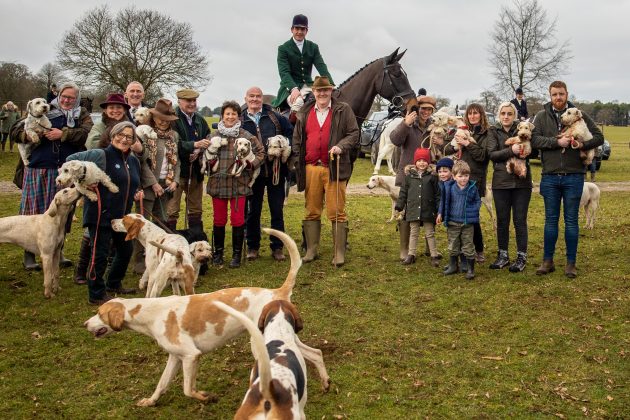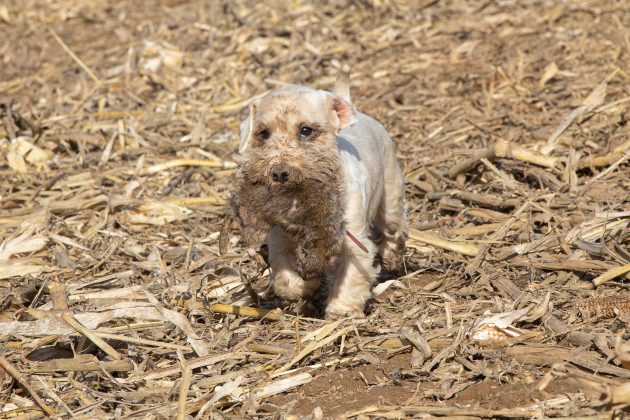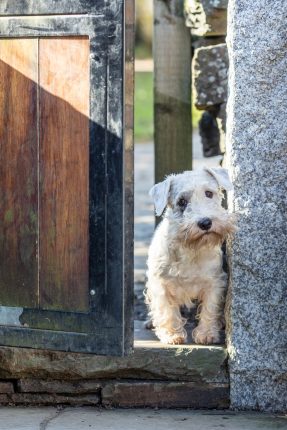The Sealyham terrier stole the show during a historic Meet at the famous Badminton estate, which brought shooting, ratting and hunting together for the day
On a slight bend in the road to the ferry ports for Ireland in Pembrokeshire, a small sign indicates a village destination a few miles distant. It may mean nothing to the weary traveller but for the devoted aficionados of a small, doughty, feisty and lovable Welsh dog, it means everything. For that sign reads ‘Sealyham’ and points the way to the 19th-century birthplace of the remarkable Sealyham terrier.
THE SEALYHAM TERRIER

It was to celebrate their abilities as ratters that they were recently invited by the Joint Masters of the Duke of Beaufort’s foxhounds and the estate’s gamekeepers to a historic Meet in the park and day on the Badminton estate. If it was a sight for the mounted followers, it was doubly so for the foxhounds, who immediately made good-mannered olfactory enquiries of their new-found canine companions. A ripple of affectionate mirth passed through the assembled foot-followers at this welcome display. “For me, it represented how any canine lover can get together with another canine lover and form a special bond,” said Beaufort Joint Master and huntsman Matt Ramsden, who had organised the Meet. “We all knew what we were doing was something totally unique, and that added to the atmosphere.”
So, what exactly is a Sealyham terrier and how did the breed originate? The Sealyham takes its name not just from the eponymous Welsh village but Sealyham house and estate itself, once the home in the 19th century of Captain John Owen Tucker-Edwardes (now an outdoor pursuits centre). A hunting man through and through, he wanted a terrier that could combat the fearsome mandible and rudder of the otters that he pursued on the rivers of the Principality. ‘The white body he insisted on as he wanted them to work with hounds but also to stand out,’ wrote Sir Jocelyn Lucas MP (after whom the Lucas terrier is named) in his book Hunt and Working Terriers (1931).

SEALYHAM TERRIER HISTORY
The Sealyham strain was developed by Edwardes between 1850 and 1891. His original cross was a working terrier of the type admired by Parson Jack Russell and a Welsh kergie or corgi. Subsequent crosses were with the Scottish Border Dandie Dinmonts and the Cheshire terrier ‘for extra gameness’. These were primarily to be working, hunting dogs. To begin with, he tested them against polecats. If the puppy went in and killed the polecat, he was added to the pack. If not, he faced a less certain future or was perhaps drafted for showing, something of which Sir Jocelyn disapproved. ‘They were never intended to be “cloddy little carthorses”,’ he wrote.
Edwardes insisted all his tenants ‘walk’ a Sealyham puppy for their landlord, alongside a stipulation in their leases that they also kept a fighting cock. Their confirmation as adults saw them weighing in at 12lb to 15lb (dogs) and 8lb to 15lb (bitches) with a height of 8in to 12in: ‘their short legs make them much more amenable to discipline’. Sir Jocelyn observed that for ratting they take some beating for their ‘quickness and activity’. He also favoured them for shooting. ‘I used to take a team of about 12 couples to covert shooting all over the country. They never let any old cock pheasant double back… Of course one had to rescue any game before they got hold of it or its culinary value was apt to decrease considerably.’

While Sealyhams are compact in form (and their benign appearance belies a fearsome hunting instinct) their owners come in all shapes and sizes, and from all over Britain. “I was brought up outside Crickhowell and had to have something Welsh to remind me of home when I got married,” Tamara Warhurst told me, out with her five-year-old daughter, Sienna, and husband Henry. Their family addition is year-old Sealyham ‘Nutty’ Nutkin.
The renowned gardener Sue Dickinson had a Sealyham terrier, Minty, growing up in Cumberland in the 1960s. “We were three sisters and she was our family dog,” she recalled. Then, on retirement in 2015, she was determined to get another Sealyham and along came Puffin, now six. “Puffin rules the roost,” continued Dickinson. “She is a loyal little terrier with character and substance. She always comes first.” Of the Meet she said: “The generosity of the Hunt and the setting was a lovely, happy gathering.”
FAMILY CONNECTION
Tizzie Craggs has been a Sealyham owner since 2010. She brought Arfur Crown, aged 10 and a half, and new arrival Farthing, just one. In 2014, aged 71, she did a parachute jump in her native Suffolk that raised more than £3,000 to support the future of the breed. Why had she chosen a Sealyham? “My mother had one in 1938 called Tuppence. My father was the only person she would not bite, so they got married on the strength of it.”

Fiona Birt-Llewellin brought Willie, who is Farthing’s father, and again there is a strong historical family connection with the breed. “I was asthmatic as a child, and the Sealyham does not shed his coat,” her husband Nigel, who farms near Sealyham village itself, explained. “We had Muffet growing up, and I now have the fourth-generation Muffet as well as Willie and Pixie.” The original Muffet bit Nigel’s brother and had to be sent away to his aunt, Jane Mounsey, best friend of Jumbo Frost. In her day, Frost was the doyenne of Sealyham breeders and secretary of the Bicester with Whaddon Chase foxhounds. “Of course, it should have been the other the way round,” joked Nigel.
Also at the Meet, and supportive of the breed and its future survival, was The Hon Rupert Soames, grandson of Sir Winston Churchill. “I have huge admiration for people who want to preserve working hounds and dogs,” he told me. “This is what they were bred to do.” There is something both charming and incongruous about often well-to-do Sealyham owners being attracted to the breed. They are like canine Oliver Twists, their owners preserving and protecting an orphan or an urchin. Be that as it may, several owners told me they slept with their Sealyhams in bed at night.

This aristocratic and ‘celebrity’ attraction to the breed was ever thus. Princess Margaret, Cary Grant, Alfred Hitchcock and Elizabeth Taylor have all been devoted owners. (Even my mother, the 1960s television quiz show hostess Gwynneth Tighe, had a Sealyham for a while in London.) In 1959, the Ephraim Hardcastle column in the Sunday Express reported: ‘A notice has been posted in Clarence House and Windsor Castle giving explicit instructions that when Princess Margaret has breakfast in bed, her two Sealyhams [Johnny and Pippin] must be brought to the room along with her breakfast tray.’
But for the working strain and modern preservation of the breed, one need look no further than Harry Parsons and his partner Gail Westcott. In 2008, they established the Working Sealyham Terrier Club and, at their wonderful kennel and home in North Devon, there is a shrine to the breed. All manner of artefacts and literature are housed in a magnificent oak-beamed barn. The Sealyhams live in barely less splendour, with individual kennels, heated at all times by a wood-burning stove, and wonderful grass yards shaded by apple trees. Would-be Sealyham owners, and indeed existing owners, come to them for advice, breeding and puppies. “We vet every prospective owner carefully,” said Parsons. “This is to make sure the owners will suit this special breed of dog and that they will, at all times, have company and be well cared for.”
A LIFE’S WORK
For Parsons the protection, promotion and propagation of the Sealyham terrier has become a life’s work. Now 65, he was brought up in London’s East End. “My earliest memories are of taking our little black-and-white terrier, Judy, rabbiting on the Hackney Marshes with my elder brother, Mark. To this day, he knows as much about the Sealyham breed as I do,” he told me. Then there were summer breaks hop-picking in Kent, where he first saw a Sealyham terrier. In 2021, however, only 184 Sealyhams were registered with the Kennel Club. In their heyday in the 1920s more than 2,000 were registered.

What about the ratting? As more than 150 mounted followers left the Meet behind Matt Ramsden and the Duke of Beaufort’s foxhounds, a conga of vehicles followed Parsons and his 10 working dogs four miles to a rusty corrugated barn on private farmland near Tormarton. Witnessing them make their first ‘draw’ among some straw bales were former Beaufort Joint Master and huntsman Captain Ian Farquhar, longserving Beaufort Field Master John White and hunt stalwart Fiona Mitchell. “They’ll never find in there,” Farquhar told me. “But then, they often said that to me about a fox.”
Within five minutes, the Sealyham terriers were working together as tightly knit as the Gorgon’s head. Interestingly, they hunt mute, only giving a cry if they get disorientated or lost. Closely observing the action were James Meade, son of triple Olympic gold medallist eventer Richard Meade, and his five-year-old twins, Billy and Rory. With whoops from their father, a rat was soon despatched in quick work. On the taking of the third rat, James asked his sons how that should be counted in sporting terms? “A leash,” the well-brought-up boys replied. Also watching closely was Adam Bromfield, the director of Roxtons sporting agency, who takes the shooting at Badminton. “It was a great occasion to see shooting, hunting and ratting come together for the day,” he said.

While Sealyhams are not ideal to run with hounds on account of their short legs, Captain WP ‘Bill’ Browne, the highly regarded Master and huntsman of the Portman in the 1920s, kept one, Sprout, for this purpose. According to his hunting diaries, they came one day to a flooded brook. ‘Sprout, with his short legs, did not like it much so, getting an old dog hound by the neck, he scrambled on his back and hung on till he got to the other side, much to his unwilling steed’s annoyance. Once safely over he did not wait for reprisals, but dodged away underneath the others and kept his distance till the storm had blown over.’ This, Sir Jocelyn Lucas observed, showed the ‘cuteness’ of the breed. It also showed that the foxhound is a pretty decent fellow too.
To make enquiries about Sealyham terriers, email gailwestcott66@gmail.com





